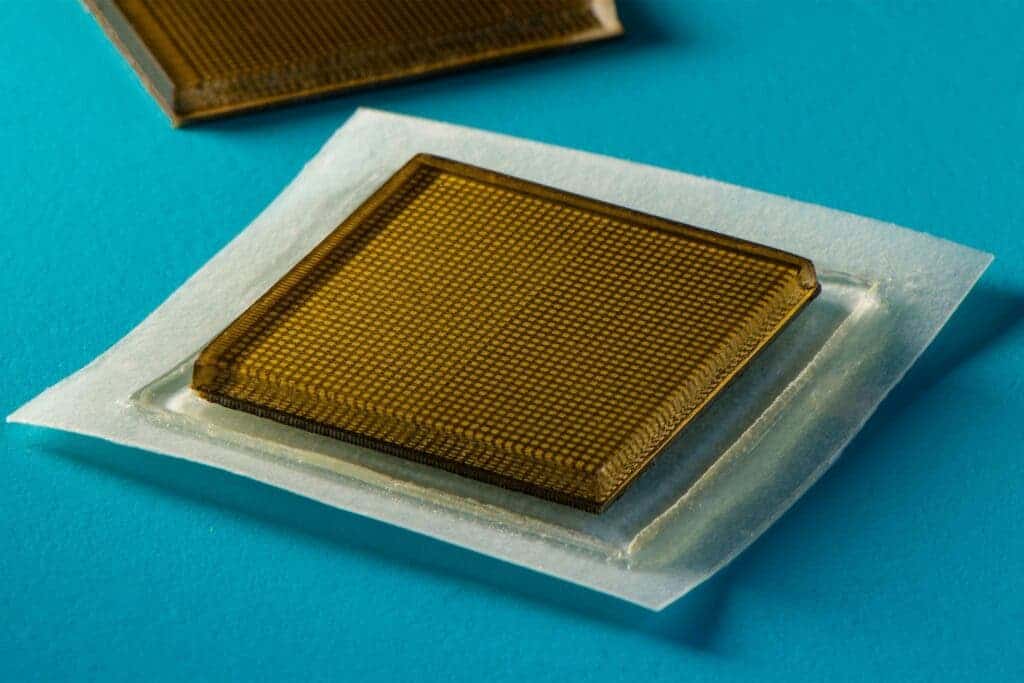Researchers at MIT want to make peering into your body much easier and more convenient, by putting ultrasound technology onto stamp-sized stickers.

Ultrasounds are one of the safest, completely noninvasive methods doctors have for observing our body’s inner workings. Many expecting parents will be familiar with this technology. It relies on sending sound waves into a patient’s body and reading their reflection to produce high-quality, live images of the patient’s internal organs.
The approach, however, involves the use of specialized, bulky machinery and ‘wands’ that are meant to direct the sound waves into the body. This means that ultrasounds are restricted to designated healthcare facilities such as hospitals or doctors’ offices. But what if that same technology could be made as wearable and widely accessible as Band-Aids? One team of researchers at MIT has done just that.
Sticking to monitoring
The team’s design is a stamp-sized device that sticks to the skin and provides continuous imaging of a user’s internal organs for up to 48 hours. During trials with volunteers, the devices proved their effectiveness by producing live, high-resolution imaging of major blood vessels as well as organs such as the heart, lungs, and stomach. The stickers maintained strong adhesion throughout the trials and could provide quality imaging when the volunteers were at rest (sitting, standing) or engaged in more strenuous activities (jogging, biking).
The stickers captured details of deeper organs, for example showing how the heart changes shape as it contracts during exercise. The researchers were also able to watch the stomach distend, then shrink back as volunteers drank then later passed juice out of their system. And as some volunteers lifted weights, the team could detect bright patterns in underlying muscles, signaling temporary microdamage.
Such stickers handle the data collection, but they need to physically connect to panels of instruments that transform raw readings into useful medical images. Despite the need for them to work in tandem with other devices, the team says they could still serve in many different applications. For example, such stickers could be applied to patients in the hospital to continuously monitor their internal organs without the need for a technician to hold a probe in place.
The ultimate goal is to make such stickers operate wirelessly, a goal that the team is already working towards. If this is achieved, the stickers can be made fully wearable, and patients could have the option to bring them home from a doctor’s office or buy them at a pharmacy.
“We envision a few patches adhered to different locations on the body, and the patches would communicate with your cellphone, where AI algorithms would analyze the images on demand,” says the study’s senior author, Xuanhe Zhao, professor of mechanical engineering and civil and environmental engineering at MIT.
“We believe we’ve opened a new era of wearable imaging: With a few patches on your body, you could see your internal organs.”
One particularly important advancement that these stickers introduce, apart from the fact that they free up a technician, is that they can operate for extended periods of time. Traditional ultrasound imaging relies on a liquid gel to transmit sound waves from the probe into a patient’s body. Over time, however, this dries or flows away, which interrupts imaging.
One alternative that has been investigated in the past is to use stretchable ultrasound probes. Made up of a flexible array with tiny ultrasound transducers, these probes would stretch to fit a patient’s body, removing the need for the gel. Although the idea does work, such probes only provide low-resolution imaging, as the transducers shift position relative to each other, which distorts the resulting image.
“Wearable ultrasound imaging tools would have huge potential in the future of clinical diagnosis. However, the resolution and imaging duration of existing ultrasound patches is relatively low, and they cannot image deep organs,” says Chonghe Wang, who is an MIT graduate student.
The design produced by the MIT team mixes the two approaches together: their stickers pair a stretchy adhesive layer with a rigid transducer array. This mix allows the device to maintain contact with the skin without allowing the transducers to move relative to one another, maintaining the accuracy of the final images. The adhesive layer is composed of two thin elastomer layers that contain a layer of solid hydrogel. While being an excellent carrier of sound waves, this hydrogel improves on traditional ultrasound gels as it is highly elastic, stretchy, and doesn’t flow away. Meanwhile, the elastomer prevents this hydrogel from drying out.
The bottom elastomer layer is meant to stick to skin, and the top layer sticks to the array of transducers — that the team also designed and fabricated.
All in all, the acoustic stickers measure around 2 square centimeters across and 3 millimeters thick.
In addition to developing a wireless version of the sticker, the team is also working on artificial intelligence applications that can better interpret and diagnose data from the stickers. Zhao envisions that the stickers could be packaged and purchased by patients and consumers, and used not only to monitor various internal organs, but also the progression of tumors, as well as the development of fetuses in the womb.
“We imagine we could have a box of stickers, each designed to image a different location of the body,” Zhao says. “We believe this represents a breakthrough in wearable devices and medical imaging.”
The paper “Bioadhesive ultrasound for long-term continuous imaging of diverse organs” has been published in the journal Science.
Was this helpful?



